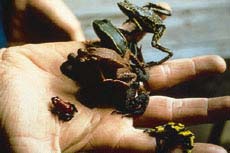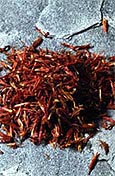The importance of rainforests
Tropical rainforests cover about 7% of the Earth's surface and are VERY important to the Earth's ecosystem. Tropical rainforest
trees and plants help controlling the world's climate. In the rainforest, it rains a lot and is very hot. When it rains, the heat makes the rainwater
evaporate back into the air. This means it's recycled (rainwater in the Amazon can be recycled five to seven times). 50% of rain in some rainforests
comes from evaporation. The clouds that cover the rainforests around the equator reflect the sun. this keeps the rainforest from getting too hot.
Rainforest canopies also absorb carbon dioxide, which is a gas in the atmosphere, and store it in their roots, stems, leaves, and branches.
When the rainforests are burned and cleared, the carbon is released. This makes the weather much hotter and is called the greenhouse effect.
In all of nature, and especially in rainforests, plants and animals depend
on each other for survival. This is called interdependence. For example, some
insects can only survive in one type of tree, while some birds only eat one type
of insect. If this tree is destroyed, the insects will have no home. If these
insects die, the birds who rely on them for food will starve to death. Because
of this interdependence, if one type of plant or animal becomes extinct, several
others could be in danger of extinction as well.
 Many animals species have developed relationships with each other that benefit both species. Birds and mammal species love to eat the tasty fruits
provided by trees. Even fish living in the Amazon River rely on fruits dropped from forest trees. In turn, the fruit trees depend upon these animals
to eat their fruit, which helps them to spread their seeds to far-off parts of the forest.
Many animals species have developed relationships with each other that benefit both species. Birds and mammal species love to eat the tasty fruits
provided by trees. Even fish living in the Amazon River rely on fruits dropped from forest trees. In turn, the fruit trees depend upon these animals
to eat their fruit, which helps them to spread their seeds to far-off parts of the forest.
In some cases both species are so dependent upon each other that if one becomes extinct, the other will as well. This nearly happened with trees that
relied on the now-extinct Dodo birds. They once roamed Mauritius, a tropical island located in the Indian Ocean. They became extinct during the late 19th
century when humans over-hunted them. The Calvaria Tree stopped sprouting seeds soon after. Scientists finally concluded that, for the seeds of the
Calvaria Tree to sprout, they needed to first be digested by the dodo bird. By force-feeding the seeds to a domestic turkey, who digested the seeds the
same way as the Dodo birds, the trees were saved. Unfortunately, humans will not be able to save each species in this same way.
 The rain forests rank as some of the Earth's most precious natural
resources. 50% of the medicines used in the world every day come from rain forest plants, and 25% of all prescription drugs have their origins there too.
The rosy
periwinkle flower, found in Madagascar, has been successfully used to treat
several forms of cancer, including Hodgkin's disease and childhood leukemia,
and the newly discovered Ancistrocladus korupensis vine in Africa may hold the
key to a new AIDS treatment. But with more and more species
disappearing from the Earth, more and more sources of possible medicines slip
away from us. And not just medicines, but almost all food originates from hybridized wild plants (including cashew nuts, Brazil nuts, bananas, pineapple,
cucumber, cocoa or chocolate, coffee, tea, papaya, mango, yams, sweet potato, vanilla, ginger, cayenne pepper, oranges, grapefruit, lemons,
limes, passion fruit, peanuts, rice, sugar cane, cereal and coconuts mostly from coastal areas). Over 50% of the fruits you eat regularly originally came
from tropical rain forests.
The rain forests rank as some of the Earth's most precious natural
resources. 50% of the medicines used in the world every day come from rain forest plants, and 25% of all prescription drugs have their origins there too.
The rosy
periwinkle flower, found in Madagascar, has been successfully used to treat
several forms of cancer, including Hodgkin's disease and childhood leukemia,
and the newly discovered Ancistrocladus korupensis vine in Africa may hold the
key to a new AIDS treatment. But with more and more species
disappearing from the Earth, more and more sources of possible medicines slip
away from us. And not just medicines, but almost all food originates from hybridized wild plants (including cashew nuts, Brazil nuts, bananas, pineapple,
cucumber, cocoa or chocolate, coffee, tea, papaya, mango, yams, sweet potato, vanilla, ginger, cayenne pepper, oranges, grapefruit, lemons,
limes, passion fruit, peanuts, rice, sugar cane, cereal and coconuts mostly from coastal areas). Over 50% of the fruits you eat regularly originally came
from tropical rain forests.
(Above picture) The garcinia punctata from Amazonian is used as a cure for diarrhea.
 It is now generally accepted by scientists, though unfortunately not by many developers, that rain forests are of more potential value as a long-term
sustainable resource when left more or less intact than when converted to pastures or other simplified habitats. Rain forests have built up the largest
standing biomass of any plant community on earth, and they have done this almost independently of soil conditions by evolving nutrient recycling.
Managed rain forests can thus provide huge amounts of valuable timber, retain the naturally thin topsoil layers, regulate run-off, and stabilize local climate.
Because rain forests contain our planet's greatest diversity of plants and animals, they also represent giant gene banks that are surely needed now and in the future
for new drugs, foods, and other products. Only a very small percentage of rain forest plants have thus far been assessed for potential chemical value.
It is now generally accepted by scientists, though unfortunately not by many developers, that rain forests are of more potential value as a long-term
sustainable resource when left more or less intact than when converted to pastures or other simplified habitats. Rain forests have built up the largest
standing biomass of any plant community on earth, and they have done this almost independently of soil conditions by evolving nutrient recycling.
Managed rain forests can thus provide huge amounts of valuable timber, retain the naturally thin topsoil layers, regulate run-off, and stabilize local climate.
Because rain forests contain our planet's greatest diversity of plants and animals, they also represent giant gene banks that are surely needed now and in the future
for new drugs, foods, and other products. Only a very small percentage of rain forest plants have thus far been assessed for potential chemical value.


 Many animals species have developed relationships with each other that benefit both species. Birds and mammal species love to eat the tasty fruits
provided by trees. Even fish living in the Amazon River rely on fruits dropped from forest trees. In turn, the fruit trees depend upon these animals
to eat their fruit, which helps them to spread their seeds to far-off parts of the forest.
Many animals species have developed relationships with each other that benefit both species. Birds and mammal species love to eat the tasty fruits
provided by trees. Even fish living in the Amazon River rely on fruits dropped from forest trees. In turn, the fruit trees depend upon these animals
to eat their fruit, which helps them to spread their seeds to far-off parts of the forest. The rain forests rank as some of the Earth's most precious natural
resources. 50% of the medicines used in the world every day come from rain forest plants, and 25% of all prescription drugs have their origins there too.
The rosy
periwinkle flower, found in Madagascar, has been successfully used to treat
several forms of cancer, including Hodgkin's disease and childhood leukemia,
and the newly discovered Ancistrocladus korupensis vine in Africa may hold the
key to a new AIDS treatment. But with more and more species
disappearing from the Earth, more and more sources of possible medicines slip
away from us. And not just medicines, but almost all food originates from hybridized wild plants (including cashew nuts, Brazil nuts, bananas, pineapple,
cucumber, cocoa or chocolate, coffee, tea, papaya, mango, yams, sweet potato, vanilla, ginger, cayenne pepper, oranges, grapefruit, lemons,
limes, passion fruit, peanuts, rice, sugar cane, cereal and coconuts mostly from coastal areas). Over 50% of the fruits you eat regularly originally came
from tropical rain forests.
The rain forests rank as some of the Earth's most precious natural
resources. 50% of the medicines used in the world every day come from rain forest plants, and 25% of all prescription drugs have their origins there too.
The rosy
periwinkle flower, found in Madagascar, has been successfully used to treat
several forms of cancer, including Hodgkin's disease and childhood leukemia,
and the newly discovered Ancistrocladus korupensis vine in Africa may hold the
key to a new AIDS treatment. But with more and more species
disappearing from the Earth, more and more sources of possible medicines slip
away from us. And not just medicines, but almost all food originates from hybridized wild plants (including cashew nuts, Brazil nuts, bananas, pineapple,
cucumber, cocoa or chocolate, coffee, tea, papaya, mango, yams, sweet potato, vanilla, ginger, cayenne pepper, oranges, grapefruit, lemons,
limes, passion fruit, peanuts, rice, sugar cane, cereal and coconuts mostly from coastal areas). Over 50% of the fruits you eat regularly originally came
from tropical rain forests.
 It is now generally accepted by scientists, though unfortunately not by many developers, that rain forests are of more potential value as a long-term
sustainable resource when left more or less intact than when converted to pastures or other simplified habitats. Rain forests have built up the largest
standing biomass of any plant community on earth, and they have done this almost independently of soil conditions by evolving nutrient recycling.
Managed rain forests can thus provide huge amounts of valuable timber, retain the naturally thin topsoil layers, regulate run-off, and stabilize local climate.
Because rain forests contain our planet's greatest diversity of plants and animals, they also represent giant gene banks that are surely needed now and in the future
for new drugs, foods, and other products. Only a very small percentage of rain forest plants have thus far been assessed for potential chemical value.
It is now generally accepted by scientists, though unfortunately not by many developers, that rain forests are of more potential value as a long-term
sustainable resource when left more or less intact than when converted to pastures or other simplified habitats. Rain forests have built up the largest
standing biomass of any plant community on earth, and they have done this almost independently of soil conditions by evolving nutrient recycling.
Managed rain forests can thus provide huge amounts of valuable timber, retain the naturally thin topsoil layers, regulate run-off, and stabilize local climate.
Because rain forests contain our planet's greatest diversity of plants and animals, they also represent giant gene banks that are surely needed now and in the future
for new drugs, foods, and other products. Only a very small percentage of rain forest plants have thus far been assessed for potential chemical value.
